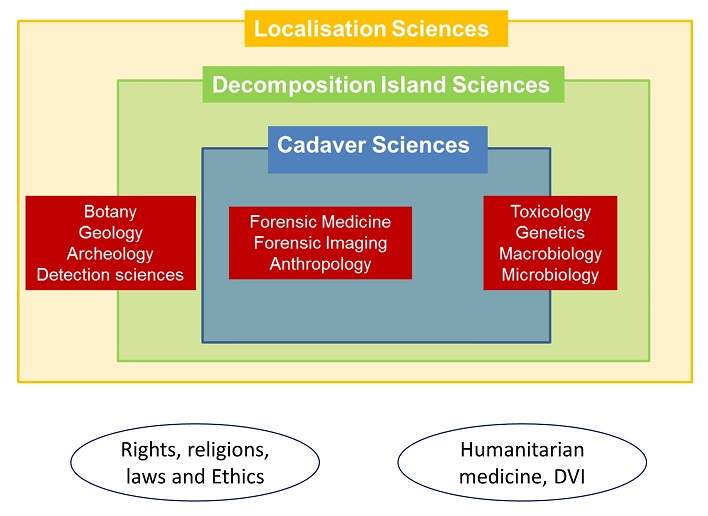
Swiss Human Institute of Forensic Taphonomy (SHIFT)
PRESENTATION | SERVICES | TRAINING & RESEARCH | FAQ
FAQ
1. What is forensic taphonomy?
Forensic taphonomy is the study and use of processes associated with cadaveric decomposition for the documentation and resolution of forensic cases, both locally (homicide, mountain accident, ...) and internationally (mass disasters, climatic and conflict zones). For example, these processes are studied and used to estimate a postmortem interval (time between death and discovery of the body) or the location of mass graves (armed conflicts).
Forensic taphonomy is integrated into many scientific disciplines, relating to the body itself (anthropology, forensic medicine and imaging, etc.), the body in interaction with the soil, otherwise known as the "decomposition island" (toxicology, genetics, forensic macro- and microbiology, etc.), in relation to the detection of the body (botany, forensic geology and archaeology, location science, etc.). Ethical, socio-cultural, humanitarian and legal dimensions are also part of the process by which taphonomy orients its research.

2. What is the purpose of forensic taphonomy research?
Recent events of global significance have highlighted the need for pragmatic research to improve methodologies for the search, location, and identification of victims of mass disasters of natural or anthropogenic origin.
These phenomena can be of different natures, for example, during volcanic eruptions (Ontake volcano in Japan, 2014), tsunamis (Sumatra in Indonesia, 2004), earthquakes (Mexico City in Mexico, 2017), floods (Queensland in Australia, 2013) or of anthropogenic origin such as nuclear (Fukushima in Japan, 2011), industrial (Qitaihe in China, 2016) or terrorist disasters (New York - September 11 in the USA, 2001).
The consequences of armed conflicts can also be of great interest to forensic taphonomy. Indeed, its methodologies are necessary for authorities and police investigations to locate and/or identify missing persons or victims of homicide.
Unfortunately, the possibilities to conduct appropriate research in Switzerland and in Europe are still lacking.
The development of taphonomy is imperative in order to carry out scientific studies that will provide answers and thus contribute to the resolution of investigations, whether in Switzerland or elsewhere in the world, when Swiss intervention and assistance is required by states near or far that are affected by large-scale disasters.
3. Is taphonomy only of interest to the forensic sciences?
Forensic taphonomy is very important because of its operational side to characterize and document deaths during events of local (homicide, accident, etc.) or international (disasters) scale.
However, human taphonomy remains much broader than forensic and humanitarian sciences. It remains a valuable tool in anthropology and traditional archaeology. It has important links with clinical medical sciences, biological and environmental sciences, geological sciences and location sciences.
Human taphonomy is also at the crossroads of human, religious, ethical and legal sciences to anticipate societal questions around our mortality.
- Why do bodies decompose badly in cemeteries?
- What is the environmental burden (contamination, energy, etc.) of our burials (burial, cremation)?
- Reflections around the deceased body and alternative burials (humusation/composting, aquamation, etc.)?
4. How to give your body to forensic science?
Our body belongs to us. It is part of our identity and we have full ownership of it. Thus, we can decide during our lifetime what will happen to our body in the context of a body donation.
Since the advent of medical science, body donation has always been seen as an altruistic and disinterested act, which allows scientific knowledge to progress and benefit future generations.
You can find more information on body donation by clicking on the following link: body donation
5. Why use human bodies?
Currently, most scientists and law enforcement agencies use animal models to study decomposition processes. While this research contributes to new knowledge, the study of human bodies provides unique knowledge that cannot be extrapolated to other species. Indeed, the animal model does not take into account many specific human parameters such as smoking status, diabetes, cardiovascular diseases, cancers, etc.
6. What are the forensic taphonomy facilities in the world involving human bodies
There are currently 8 forensic taphonomy institutions involving human bodies in the United States (University of Tennessee, Oak Ridge National Laboratory, Southern Illinois University, Colorado Mesa University, South Florida University, Sam Houston University, and San Marcos University), 1 in Australia (University of Technology Sydney), 1 in the Netherlands (Amsterdam University), and 1 in Canada (Université du Québec-Trois Rivières). SHIFT maintains close and privileged ties with most of these institutions.
7. How can I study or obtain an internship at SHIFT?
Swiss or foreign students wishing to specialize in taphonomy (physicians, scientists and post-graduate students with an interest in this field), can send their application to: shift@chuv.ch.
Taking into account the ethical dimensions and specific characteristics of taphonomic research, each application will be considered according to a rigorous protocol. Previous experience in forensic science is generally a prerequisite.
Please note that internships are unpaid.

